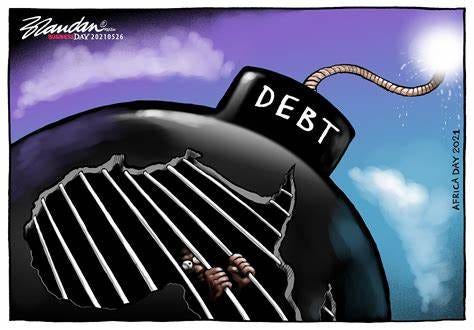Debt Crisis Looms as Poor Nations Prioritize Repayments Over Development
The webinar, the first in a four-part series, brought together experts from various international organizations to discuss challenges and potential solutions to the debt crisis.
HARARE, Zimbabwe —A looming global debt crisis threatens to derail development in the world's poorest nations, with countries allocating more funds to debt repayments than essential services, experts warned during a Westminster Foundation for Democracy (WFD)-African Forum and Network on Debt and Development (AFRODAD) webinar on public debt transparency, writes Winston Mwale.
Anthony Smith, WFD's chief executive, opened the webinar by highlighting the severity of the situation.
"The 25 poorest countries spend more on debt repayments than on education, health, and social policy combined," Smith said.
He added that 60% of low- and middle-income countries are now considered highly debt vulnerable.
The webinar, the first in a four-part series, brought together experts from various international organizations to discuss challenges and potential solutions to the debt crisis.
Participants included representatives from the World Bank, the International Budget Partnership (IBP), and the Institute of Public Finance in Kenya.
Lars Jessen, lead debt specialist at the World Bank, emphasized the importance of clear legislation and roles in debt management.
"Having clear roles for the debt management office and other entities involved is really important," Jessen stated.
He outlined key principles for effective debt transparency, including easy access to information and clear public disclosure of debt management operations.
Jessen also highlighted the challenges in publishing information on contingent liabilities, particularly implicit ones.
"There are limits as to how much you can publish, especially when it comes to some of these contingent liabilities," he explained.
Austin Ndiokwelu from the International Budget Partnership presented findings from their Open Budget Survey, which assesses transparency across the budget cycle.
"We discovered that in totality, we had an average of 30 over 100 for debt transparency indicators in 41 African countries," Ndiokwelu reported.
This score, where zero means no transparency and 100 indicates perfect information, underscores the significant room for improvement in debt transparency across the continent.
Ndiokwelu elaborated on the survey's findings, noting that while many countries provide basic information on new borrowings and total debt stock, fewer offer detailed data on debt composition, interest rates, and maturity profiles.
Even scarcer is information on contingent liabilities and long-term fiscal sustainability.
Ruth Kendagor from the Institute of Public Finance in Kenya provided insights into her country's progress on debt transparency.
"Kenya has made strides in developing a legal framework for debt transparency," Kendagor said. However, she noted that challenges remain in the timeliness and comprehensiveness of information provided.
Experts stressed the need for improved debt recording systems and well-organized back offices to enhance transparency.
They also called for greater involvement of civil society organizations (CSOs) and parliaments in debt oversight.
The role of parliaments in ensuring debt transparency was a key topic of discussion.
Speakers emphasized the importance of parliamentary budget offices with high capacity to analyze and interpret debt information effectively.
They also highlighted the need for coherence across policy documents related to debt.
The World Bank's efforts to improve debt data accessibility were also discussed. Jessen noted that 45 countries now publish regular debt bulletins, up from 19 four years ago.
Additionally, more countries are publishing debt management strategies and annual borrowing plans.
However, participants agreed that more needs to be done to advocate for countries to have the ability to publish timely, high-quality information.
This includes breaking down complex debt information into unambiguous language for citizens and addressing challenges in obtaining factual debt information from governments.
The role of civil society organizations in promoting debt transparency was another focal point of the webinar.
Experts emphasized that CSOs can help bridge the gap between government and citizens on debt information.
They suggested that CSOs should engage from the early stages of debt policy formulation and time their advocacy efforts strategically.
Participants also discussed the lack of debt information even among senior government officials in some countries, highlighting the need for capacity building at all levels.
They noted that some of the best debt management websites often come from countries in debt crises, suggesting that financial distress can sometimes lead to improved transparency practices.
The webinar concluded with a call to action for stakeholders to work together in improving debt transparency and management practices globally.
Key recommendations included:
Developing comprehensive public debt management legal frameworks with clear disclosure provisions.
Addressing limitations in confidentiality clauses that hinder transparency.
Building capacity among CSOs on both technical and political aspects of debt management.
Encouraging partnerships between CSOs and other accountability actors like audit institutions and media.
Pushing for strong legal frameworks to guide debt management throughout the debt/budget cycle.
Shem Joshua Otieno, representing AFRODAD, emphasized that debt transparency is not just a data issue but also a creditor issue.
He called for both debtors and creditors to play their part in ensuring transparency.
As the global community grapples with rising debt levels and their impact on development, the insights and recommendations from this webinar serve as a crucial starting point for addressing the challenges ahead.
With the next webinar in the series focusing on transforming public debt management, stakeholders are encouraged to continue engaging in this vital dialogue.
The urgency of the situation was underscored by the World Bank's recent International Debt Report, which revealed the sharpest rise in global borrowing costs in four decades.
As countries like Sri Lanka and Kenya face social and political upheaval linked to debt crises, the need for transparent and accountable debt management has never been more critical.
As the webinar concluded, participants were reminded of the upcoming sessions in the series and encouraged to register for the next event.
The collective expertise and commitment displayed during this initial discussion provide hope that, with concerted effort and cooperation, the looming debt crisis can be addressed, ensuring that the world's poorest nations can prioritize development over debt repayments.




